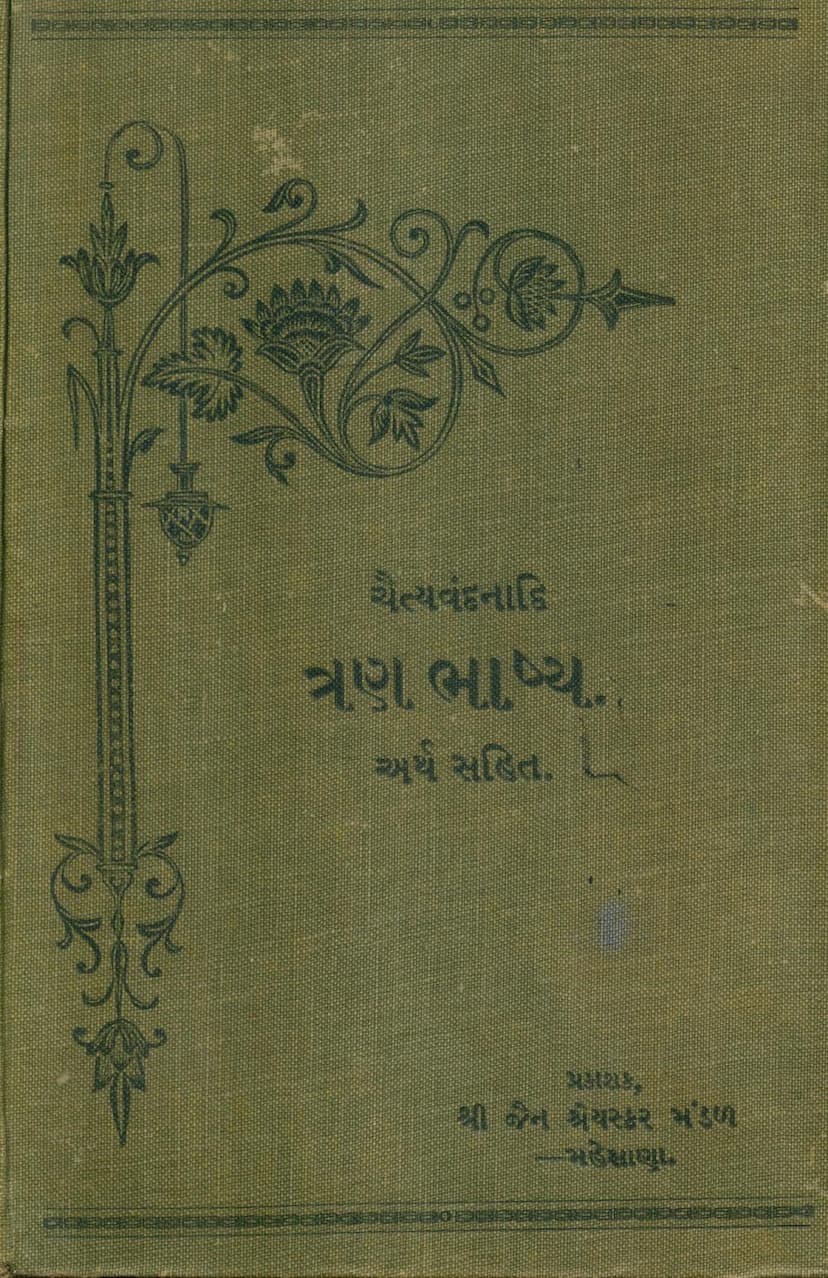Tran Bhashya Bhavarth Ahit
Added to library: September 2, 2025

Summary
Here's a comprehensive summary of the Jain text "Tran Bhashya Bhavarth ahit" (Translation: Three Commentaries with Exposition of Meaning), compiled by Jain Shreyaskar Mandal Mahesana. The text appears to be a detailed guide to rituals and principles within Jainism, focusing on three core aspects: Devatatva (Divinity), Gurutatva (The Guru), and Dharmatatva (Religion).
Book Title: Tran Bhashya Bhavarth ahit Author(s): Jain Shreyaskar Mandal Mahesana Publisher: Jain Shreyaskar Mandal Mahesana Catalog Link: https://jainqq.org/explore/006017/1
Overall Purpose and Structure:
The book is a guide for those who wish to understand and practice the principles of Jainism related to divinity, gurus, and the path of religion. It presents three main "Bhashyas" (commentaries or expositions) that detail specific rituals and their underlying meanings. The text emphasizes the "Vidhimarg" (path of rituals) and "Kriyamarg" (path of action) within Jainism.
Key Components:
The book is structured around three Bhashyas, each dedicated to a fundamental element of Jainism:
-
Chaityavandan Bhashya (Chapter on Salutation to Chaityas/Temples):
- Focus: This section is dedicated to Devatatva (Divinity), specifically the worship and veneration of Arihant Dev (Tirthankaras).
- Content: It outlines the ritualistic procedure for saluting the divine, detailing various forms of worship through twenty-four "dwaras" (gateways or aspects) and 2074 "bel" (details or sub-aspects).
- Key Aspects Covered:
- Salutations to Arihants in various forms: Nama Jin (by name), Sthapana Jin (installed idols), Bhava Jin (through contemplation), all Jin forms in the three worlds, current living Jin, and Jin forms through scriptural knowledge.
- Veneration of sacred pilgrimage sites like Girnar and Ashtapad.
- Remembrance of guardian deities of the Shasan (the Jain faith).
- The text clarifies that the core Chaityavandan Sutra, Dwadashavandan Sutra, and Pratyakhyana verses are assumed to be known from other prominent texts like Pratikraman Sutra.
-
Guruvandan Bhashya (Chapter on Salutation to the Guru):
- Focus: This section addresses Gurutatva (The Guru), detailing the respect and veneration due to spiritual guides.
- Content: It outlines the rituals for saluting the Guru, covering various aspects of interaction within the four-fold Jain community (monks, nuns, laymen, and laywomen).
- Key Aspects Covered:
- The method of saluting Acharyas and other high-ranking monks with twelve "avarta" (revolutions or repetitions).
- Mutual salutations within the Sangha (community).
- Identifying those who are not to be saluted (Avandaniya Sadhu) and those who are to be saluted (Vandaniya Sadhu).
- Appropriate times for salutation.
- The importance of Vinaya (humility and respect) as the root of Dharma, knowledge, and conduct.
- Three types of Guruvandan: Kittalavandan (salutation of the body/gestures), Chhobhavandan (salutation with KhamaSamana), and Dwadashavartanvandan (twelve-fold salutation).
- Detailed explanation of the three types of salutations and to whom they are applicable (Sangha, Sadhvi, Shravak, Acharya).
- Discussion on the importance of proper conduct and etiquette when approaching and interacting with the Guru.
- Analysis of 33 types of offenses (Ashatanas) to be avoided towards the Guru.
- The rituals of Patih, Sthapana, and the significance of the Guru's presence.
- The structure and meaning of the 25 "Avashyakas" (essential actions/rituals) related to Guruvandan.
-
Pratyakhyana Bhashya (Chapter on Renunciation/Abstinence):
- Focus: This section deals with Dharmatatva (Religion), specifically the practice of Pratyakhyana (renunciation, abstinence, or setting limits on actions and consumption).
- Content: It details the ten types of Pratyakhyana, the four types of food (Ashan, Pan, Khadim, Swadim), twenty-two types of exceptions (Aghar), ten types of Vighai (items that alter the nature of food), thirty types of "Niviyata" (transformed or purified items), and the six types of purity in performing Pratyakhyana.
- Key Aspects Covered:
- Ten types of Pratyakhyana: Anagat (future), Atikrant (past), Kotisahit (with numerical count), Niyantrit (controlled), Anagar (without domestic attachment), Sagar (with domestic attachment), Niravshesh (complete), Parimanakrit (limited), Sanket (symbolic), and Addha (time-bound).
- Four types of food: Ashan (solid food), Pan (drinks), Khadim (chewable items), and Swadim (lickable items).
- Twenty-two types of Aghar (exceptions or allowances) in Pratyakhyana.
- Ten types of Vighai (items that alter food's nature, e.g., milk, ghee, yogurt, oil, jaggery, cooked food) and thirty types of their Niviyata (purified forms).
- Four categories of Abhakshya Vighai (inedible/forbidden items) like meat, honey, alcohol, and oil.
- Six types of purity in performing Pratyakhyana (regarding faith, knowledge, conduct, etc.).
- The ultimate fruits of Pratyakhyana in this world and the next.
- Detailed explanation of the ritualistic utterances (Achara) associated with taking Pratyakhyana.
- The significance of the Guru's instructions and the consequences of the disciple's adherence or deviation.
Underlying Principles and Themes:
- Respect for Authority: The text places significant importance on respecting the divine (Arihants) and the Guru.
- Ritualistic Purity: A strong emphasis is placed on performing rituals with utmost care, purity, and adherence to prescribed procedures.
- Diligence and Mindfulness: The detailed enumeration of aspects, exceptions, and offenses highlights the need for constant mindfulness and diligence in spiritual practice.
- Progressive Path: The three Bhashyas suggest a progression from venerating the divine, to respecting the spiritual guide, and finally to practicing renunciation and self-control.
- Commentarial Tradition: The text references earlier commentaries and scriptures, indicating its place within the rich Jain commentarial tradition. It mentions deriving its content from Siddhantas, Niryuktis, Bhashyas, Churnis, and Vruttis, acknowledging the contributions of various revered Acharyas like Devendrasuri, Somasundarsuri, Shanthisuri, and Dhanapal.
In essence, "Tran Bhashya Bhavarth ahit" serves as a comprehensive manual for Jains, guiding them through essential devotional practices and the philosophical underpinnings of their faith, with a particular focus on the correct performance of Chaityavandan and Guruvandan, and the meticulous practice of Pratyakhyana.